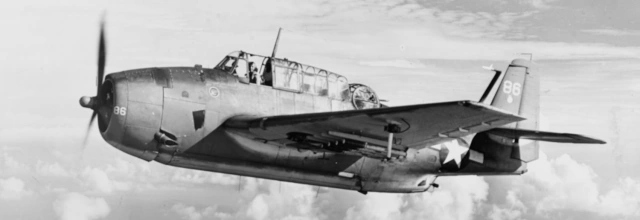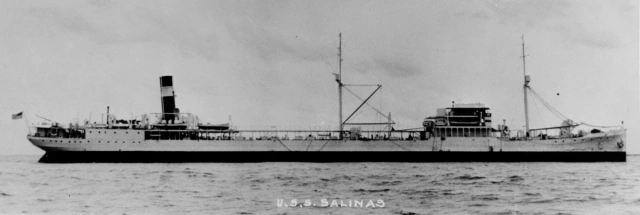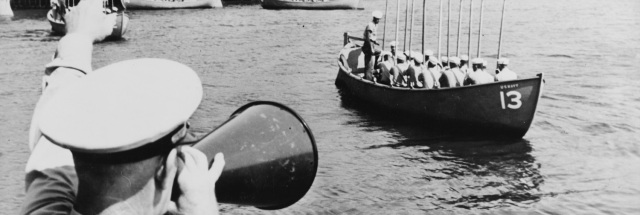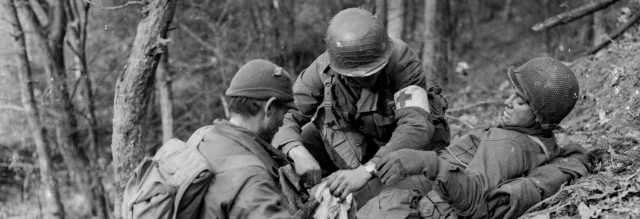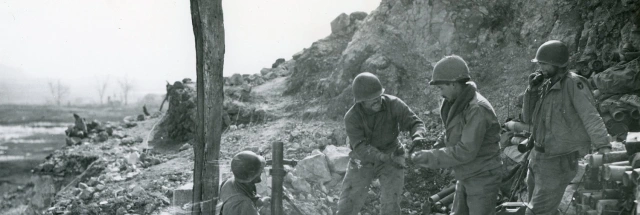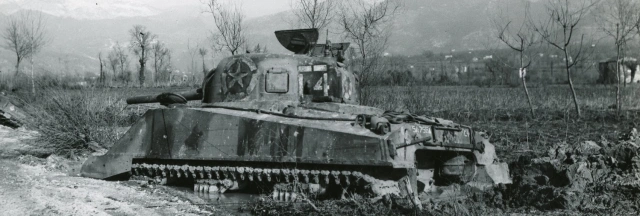| Residences | Civilian Occupation |
| Delaware, Pennsylvania | Worker for Sun Shipbuilding & Dry Dock Company |
| Branch | Service Number |
| U.S. Army | 33589277 |
| Theater | Unit |
| Mediterranean | Company “K,” 135th Infantry Regiment, 34th Infantry Division |
| Military Occupational Specialty | Campaigns/Battles |
| 761 (scout) | North Apennines campaign |
Early Life & Family
Norman George Becker was born in New Castle, Delaware, on May 21, 1923. He was the son of Henry Norman Becker (1898–1957) and Catherine Mary Becker (née Sharp, 1893–1968). His father served in the U.S. Army during World War I. Becker had three older half-sisters and two older half-brothers from his mother’s first marriage to George W. Ferris (1888–1917). He also had a younger brother and a younger sister.
Becker’s parents were separated by 1930. The Commonwealth of Pennsylvania World War II Veterans’ Compensation Bureau concluded in 1951 that Henry Becker “is declared ineligible” for any bonus for his son’s World War II service “because of the fact that he deserted his family many years ago.”
Becker was recorded on the 1930 census living on School Street in New Castle with his mother and six of his siblings. By the time of the next census, taken on April 19, 1940, Becker was a lodger living on Baltimore Pike in Birmingham Township, Delaware County, Pennsylvania. (His mother and siblings were living in New Castle at the time.)
Becker graduated from West Chester High School in Pennsylvania in 1941. His senior yearbook stated:
Norman came to this school from Chadds Ford at the beginning of his junior year and has done well here. He is active in most sports. Although he plans to go to business college to become an accountant, he has hopes of someday crashing Big League baseball.
When he registered for the draft on June 30, 1942, Becker was living at 110 Price Street in West Chester. His employer was the Sun Shipbuilding & Dry Dock Company in Chester, Pennsylvania. The registrar described him as standing about five feet, 10 inches tall and weighing 160 lbs., with black hair and brown eyes. His enlistment data card described Becker as working in “unskilled occupations in building transportation equipment (except automobiles and aircraft),” suggesting he was still working at the shipyard when he entered the service, though his name did not appear in an honor roll of fallen Sun Shipbuilding & Dry Dock Company employees published in October 1945. Journal-Every Evening reported that “Becker had made his home before induction in 1942 [sic] with Mr. and Mrs. Thomas W. Fling, West Chester, Pa.”
Becker’s two older half-brothers, George S. Ferris (1914–1984) and Charles A. Ferris (1916–1997), served in the U.S. Army during World War II, while his younger brother, William F. Becker (1924–1967) served in the U.S. Navy.
Military Career
After he was drafted, Becker was inducted into the U.S. Army in Philadelphia, Pennsylvania, on March 3, 1943. There are very few details available in extant records about the first 18 months of his military career. It appears that he was briefly stationed at Ford George G. Meade, Maryland, before going overseas to Italy as a replacement, possibly in June 1944.
Allied forces had invaded mainland Italy in September 1943. The narrow and largely mountainous Italian peninsula had proven ideal for German defensive warfare. Every time the Allies broke a defensive line, the Germans retreated in good order to the next already-prepared defensive line to the north. After the invasions of Normandy and the South of France in mid-1944, most Allied resources were diverted to northwest Europe. Allied forces in Italy kept pressure on the Germans, tying down significant resources that would otherwise have been committed to the Eastern or Western fronts, but Allied strength in Italy was never enough for any decisive breakthroughs until nearly the end of the war.
Private Becker was with the 8th Replacement Depot when he was transferred to Company “K,” 135th Infantry Regiment, 34th Infantry Division, per Special Orders No. 209, Headquarters 34th Infantry Division, dated October 3, 1944.
On October 9, 1944, the day Private Becker and nine other men from the 8th Replacement Depot joined Company “K,” it was in the 3rd Battalion assembly area near Monzuno. Although in reserve, the battalion was subjected to light harassing artillery fire. Becker had to acclimate quickly to his new unit, which was in the midst of the North Apennines campaign in the hilly country south of Bologna.
According to a morning report, Becker’s Military Occupational Specialty (M.O.S.) and his duty with his new unit were recorded as 761, scout. Under World War II U.S. Army doctrine, two riflemen in each 12-man rifle squad were designated as scouts. Pairs of scouts would precede the main body of the rifle company during advances, reconnoitering enemy positions and quietly eliminating enemy sentries when possible. They were not expected to overcome strong enemy positions by themselves, but to take cover and either mark the positions with tracer fire or report back.


The 135th Infantry had begun the month of October 1944 in reserve, but returned to combat on October 8, 1944. 2nd Battalion of the 135th Infantry began the advance, which soon bogged down due to large minefields and strong enemy resistance.
Attacks by 1st and 2nd Battalion were repulsed by the German defenders on October 10, 1944, so the Americans bombarded the enemy positions with heavy artillery fire. The Company “K” morning report on October 10, 1944, stated that morale and food were good and the men were “Getting ready to move to new area.”
Private Becker entered combat for the first time on October 11, 1944. The regimental after action report for the month stated:
The Third Battalion passed through the Second Battalion in the morning of October 11th, attacking at 0600 with the First Battalion thrusting forward on the right. It was planned for “I” Company to work to the left, shooting into draws that the enemy had used to cause the Second Battalion considerable difficulty the day before. “K” Company was to move to the northwest and across Hill 410 toward Hill 446. “K” and “I”, supported by chemical mortars, were to meet at the lateral road in the 8228 [roughly 44° 18’ 29” North, 11° 15’ 55” East] grid square. The attack started on schedule and at 0845 the Third Battalion reported that one platoon was on the southwest slope of Hill 446, and one squad was close to the top. Most of the enemy opposition came from small arms fire. We were using 240 mm howitzers against every occupied house.
The Third Battalion was moving slowly in the face of heavy mortar, small arms and automatic weapons fire. “K” Company was stopped after advancing approximately 300 yards.
Company “K” recorded casualties of three dead and 10 wounded that day, while total reported regimental casualties were five dead, 32 wounded, and 11 missing.
The 135th Infantry report continued:
Another attack was launched by the Third Battalion at 0600 on October 12, the plan calling for pulling back “I” Company, placing mortar fire where they had been, and artillery and chemical mortar fire to each side and to the north. “L” Company was to go past “I” Company, having as its objective the lateral road in the vicinity of 823284 [44° 18’ 43” North, 11° 16’ 08” East] to 830284 [44° 18’ 43” North, 11° 16’ 39” East]. “K” Company’s objective was to be the road junction. It was not possible to utilize tanks because of the softness of the ground.
The Company “K” morning report that day stated that the unit was involved in “Heavy hand to hand fighting at close range. Drawing fire from 3 sides. Captured 6 PW [prisoners of war], morale, low, food, good, water, none, weather, cloudy.” Reported regimental casualties were four dead, all of them from Company “K,” and 14 wounded (four of them from Company “K”).
That evening, according to the regimental history: “Second Battalion passed through the Third Battalion at 2005 and the First and Second Battalions prepared to resume the attack on the morning of October 13th. The weather was such that even bulldozers were being mired in the mud.” Regimental casualties recorded on October 13, 1944, were similar to the previous day: seven men killed in action (three from Company “K”) and 14 wounded (four from Company “K”).
A morning report stated that Private Becker was killed in action on October 14, 1944. The record of events in the Company “K” morning report that date stated that the unit was attached to Combat Command “A” of the 1st Armored Division for an assault on Hill 410, though the regimental journal indicates much of the day’s fighting was north of the hill. The morning report summarized the day as “heavy fighting. Morale low, food, good, weather, clear and cool.”

The regimental journal provides glimpses of the day’s events. At 0235 hours a report from a Captain Childress was recorded:
Checked with the 3rd Bn S-3 [operations officer Captain William B. Cole] for their position and situation. He says “L” and “K” Co’s are moving and at last report “L” Co was on hill 469 and “K” Co on hill 410, but they have both been moving slow since that report was received, so they are a little ahead of that by now.
The next report about Company “K” came in at 0420 hours, in which Captain Cole stated the company was “last reported moving slowly due North from hill 410, this company is being urged to move more quickly.”
At 0930 hours, a report from the Combat Command “A” S-3 to the 135th Infantry headquarters stated:
K Co at 834282 [44° 18’ 37” North, 11° 16’ 58” East]. I & K Co’s now in fire fight but think they will advance shortly. L Co reports what they believe to be enemy c/a [counterattack] forming on reverse slop of H[ill] 427, are planning to put mortar on them.
An entry at 1540 hours stated that 3rd Battalion commanding officer Lieutenant Colonel John W. Joyce reported that Companies “I” and “K” were held up by German soldiers firing from a cliff. He requested 4.2 inch mortars for support due to his men’s close proximity to the enemy. Heavier artillery would have presented danger since “3RD Bn CO said he had no communications with his forward elements should the shots fall short and the company wants to call for cease fire and furthermore there was no other people there who could make satisfactory observation over this target[.]” Regimental headquarters contacted the 1st Battalion commander, Lieutenant Colonel Charles H. Thompson, who “said they had excellent observation over this area from their CP [command post].” The enemy was apparently sheltering in caves among the cliffs.
After the bombardment, 3rd Battalion reported at 1920 hours that they were advancing and that two men who had been trapped behind enemy lines for days had been rescued. The final journal entry about Becker’s company that day, from Captain Cole at 2030 hours, stated: “Reports K Co at 834286 [44° 18’ 50” North, 11° 16’ 57” East], meeting little resistance; going for Monterumici. Two of our men who were behind enemy lines report the enemy in front of K Co pulled out last night.”

The 135th Infantry Regiment casualties for October 14, 1944, were reported as a total of 12 men killed in action, 56 wounded, and 38 missing. Of those, Company “K” losses were reported as two dead, including Becker, and six wounded.
If the coordinates were accurate, Company “K” had advanced a quarter of a mile between 0930 and 1920. The grueling combat in the Apennines would continue through the fall and winter. Bologna, less than 13 miles north of where Private Becker was killed, would not fall until April 1945, shortly before the capitulation of the Nazi regime.
According to his burial report, Private Becker suffered fatal penetrating wounds to his chest and abdomen. A letter dated November 27, 1944, to Becker’s mother from Lieutenant Colonel Charles P. Greyer, the regimental executive officer at the time of Becker’s death, stated: “Your son[,] a rifleman , was killed in action on the 14 October 1944 by enemy machine gun fire in an attack against German strongpoints. He was hit in the chest and died immediately.”
Among the effects found on Private Becker’s body were a ring, his wallet, address book, and photos.


Becker was initially buried at a temporary military cemetery at Castelfiorentino, Italy, on October 20, 1944. He was posthumously awarded the Purple Heart. Based on the rules in place at the time, a slain, unmarried soldier’s father had precedence over his mother for purposes of decision final disposition of the body. It took the War Department months of searching before they could locate Becker’s father in Baltimore, Mayland, in early 1949. He requested that his son remain in a permanent military cemetery overseas. Private Becker’s body was reinterred at what is now known as the Florence American Cemetery (Plot C, Row 14, Grave 31).
Notes
Mother’s Statement
Becker’s mother’s statement for the State of Delaware Public Archives Commission has some inaccurate information and other information that is doubtful or unconfirmed. She stated that her son joined the U.S. Army in West Chester, Pennsylvania, in March 1942, whereas his enlistment data card and Pennsylvania bonus paperwork shows he was inducted in Philadelphia in March 1943.
She also stated that he had been promoted to private 1st class and then corporal. This is certainly plausible given his time in service but if true, he was reduced to private before joining his final unit.
Finally, she also wrote that he shipped out of Baltimore for Italy in June 1943. Baltimore was used primarily for cargo. It is more likely that he shipped out of the Hampton Roads Port of Embarkation, and a June 1944 departure is more likely.
South of France?
Curiously, Journal-Every Evening stated that Becker “served in Italy before going to Southern France with the Seventh Army.” The Seventh Army landed in the South of France on August 15, 1944. If the newspaper is correct, Becker would have arrived in Italy, moved to France during the summer of 1944, and then transferred back to the Fifth Army in Italy less than two months later. Although by no means impossible, this sort of shuffle seems unlikely and may have been based on an erroneous belief that his unit was among those that moved from Italy to France.
The newspaper also reported his induction date and number of siblings inaccurately. If Becker’s mother was the only source of information, and her understanding of her son’s movements was inaccurate, it may explain the error.
761 (Scout)
Oddly enough, under the February 1944 revision of Table of Organization and Equipment No. 7-17: Infantry Rifle Company, which was in effect by the time Private Becker entered combat, a rifle company did not have any 761s. FM 7-10: Rifle Company, Infantry Regiment demonstrates that scouts still existed, but it seems they did not have a distinct M.O.S. code from 745, rifleman. Similarly, the squad leader lost its distinctive code, 653. Despite the changes in the tables of organization, supposedly obsolete M.O.S. codes persisted in morning reports through the end of the war.
Regimental History for October 14, 1944
Oddly enough, the regimental after action report narrative doesn’t mention Private Becker’s 3rd Battalion at all on October 14, 1944, discussing only 1st and 2nd Battalions: “Neither battalion, on a day that was clear with good visibility, was able to move to any appreciable degree because of small arms, mortar and scattering S/P [self-propelled artillery] fire.” The Company “K” morning report and the regimental journal does show that 3rd Battalion was in combat.
Acknowledgments
Special thanks to the Delaware Public Archives for the use of their photo and letter.
Bibliography
Becker, Catherine. Individual Military Service Record for Norman George Becker. March 28, 1946. Record Group 1325-003-053, Record of Delawareans Who Died in World War II. Delaware Public Archives, Dover, Delaware. https://cdm16397.contentdm.oclc.org/digital/collection/p15323coll6/id/17620/rec/3
Fifteenth Census of the United States, 1930. Record Group 29, Records of the Bureau of the Census. National Archives at Washington, D.C. https://www.ancestry.com/imageviewer/collections/6224/images/4531891_00291
FM 7-10: Rifle Company, Infantry Regiment. War Department, March 18, 1944.
Garnet and White 1941. https://www.ancestry.com/imageviewer/collections/1265/images/43134_b183071-00021
Greyer, Charles P. Letter to Catherine Becker, November 27, 1944.
Headstone Inscription and Interment Records for U.S. Military Cemeteries on Foreign Soil, 1942–1949. Record Group 117, Records of the American Battle Monuments Commission, 1918–c. 1995. National Archives at Washington, D.C. https://www.ancestry.com/imageviewer/collections/9170/images/42861_647350_0536-00067
“Henry Becker.” Wilmington Morning News, April 9, 1957. https://www.newspapers.com/article/135457600/
Individual Deceased Personnel File for Norman G. Becker. Army Individual Deceased Personnel Files, 1942–1970. Record Group 92, Records of the Office of the Quartermaster General, 1774–1985. National Archives at St. Louis, Missouri.
“Maryland Men Given Medals.” The Sun, November 26, 1944. https://www.newspapers.com/article/135457297/
Morning reports for Company “K,” 135th Infantry Regiment. October 1944. U.S. Army Morning Reports, c. 1912–1946. Record Group 64, Records of the National Archives and Records Administration. National Archives at St. Louis, Missouri.
Our Yard, October 1945. Sun Shipbuilding and Dry Dock Company magazine. http://www.sunship.org/ouryard/oy_issue_scans/705_4510.pdf
“Regimental History–135th Inf Regt–34th Inf Div Oct 1944.” World War II Operations Reports, 1940–48. Record Group 407, Records of the Adjutant General’s Office. National Archives at College Park, Maryland.
Sixteenth Census of the United States, 1940. Record Group 29, Records of the Bureau of the Census. National Archives at Washington, D.C. https://www.ancestry.com/imageviewer/collections/2442/images/M-T0627-03487-00217, https://www.ancestry.com/imageviewer/collections/2442/images/m-t0627-00546-00419
“Table of Organization and Equipment No. 7-17: Infantry Rifle Company.” War Department, February 26, 1944. Military Research Service website. http://www.militaryresearch.org/7-17%2026Feb44.pdf
“Three Dead On Casualty List of State.” Journal-Every Evening, November 28, 1944. https://www.newspapers.com/article/135456941/
U.S. WWII Hospital Admission Card Files, 1942–1954. Record Group 112, Records of the Office of the Surgeon General (Army), 1775–1994. National Archives at College Park, Maryland. https://www.fold3.com/record/705137950/becker-norman-g-us-wwii-hospital-admission-card-files-1942-1954
World War II Army Enlistment Records. Record Group 64, Records of the National Archives and Records Administration. National Archives at College Park, Maryland. https://aad.archives.gov/aad/record-detail.jsp?dt=893&mtch=1&cat=all&tf=F&q=33589277&bc=&rpp=10&pg=1&rid=4062282
World War II Veterans Compensation Applications. Record Group 19, Series 19.92, Records of the Department of Military and Veterans Affairs. Pennsylvania Historical and Museum Commission, Harrisburg, Pennsylvania. https://www.ancestry.com/imageviewer/collections/3147/images/41226_622204_0835-01316
WWII Draft Registration Cards for Pennsylvania, October 16, 1940 – March 31, 1947. Record Group 147, Records of the Selective Service System. National Archives at St. Louis, Missouri. https://www.ancestry.com/imageviewer/collections/2238/images/44033_04_00028-00742
Last updated on November 25, 2023
More stories of World War II fallen:
To have new profiles of fallen soldiers delivered to your inbox, please subscribe below.






